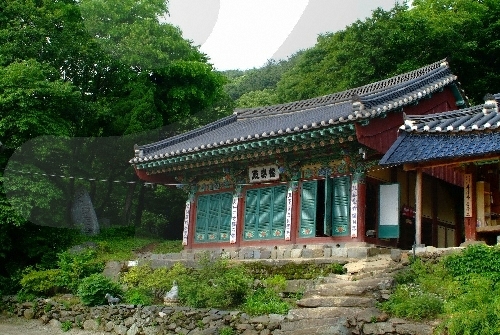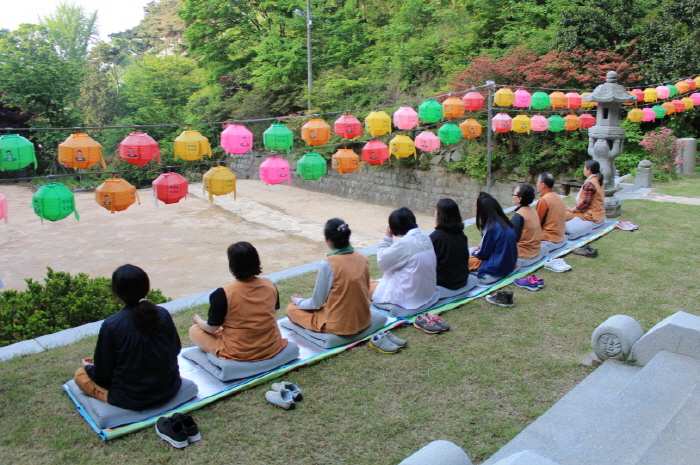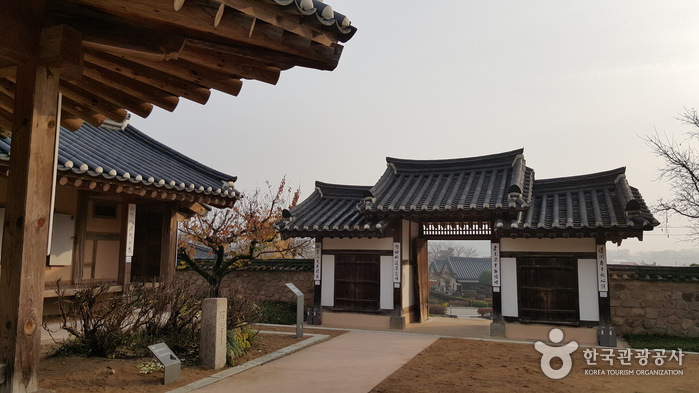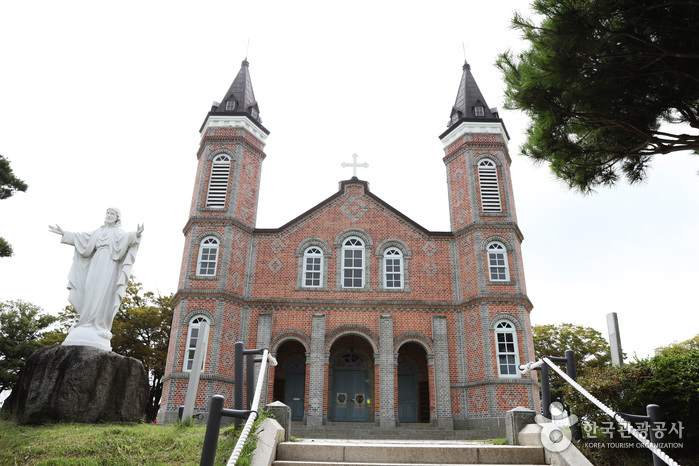Lotte Himart - Seosan Lotte Mart Branch [Tax Refund Shop] (롯데하이마트 서산롯데마트점)
17.0Km 0 2024-04-19
27, Chungui-ro, Seosan-si, Chungcheongnam-do
-
Lotte Mart - Seosan Branch [Tax Refund Shop] (롯데마트 서산점 [사후면세점])
17.0Km 0 2024-04-22
6 lots, 27, Chungui-ro, Seosan-si, Chungcheongnam-do
-
Yesan Hwaamsa Temple (화암사 (예산)
17.4Km 7473 2020-04-04
21-29, Yonggung 1-gil, Yesan-gun, Chungcheongnam-do
+82-41-332-9250
Hwaamsa Temple is located near Joseon dynasty's scholar and writer Kim Jeong-hui's, also referred to his pen name Chusa, house. The temple has ties with the ancient writer, as the temple is known to have been repaired and renovated by Kim Jeong-hui's great grandfather. There are no records that explains the foundation of Hwaamsa Temple, and only a timeline of its reconstruction can be found in "Records of Hwaamsa Temple Restoration" plaque, which is displayed in Sudeoksa Temple Museum. The timeline was recorded by Kim Myeong-hee in 1848, and written by Kim Seong-hee, and carved by Cho Seok-shin. The name "Hwaamsa" was given by King Yeongjo (r. 1724-1776).
Seosan Buseoksa Temple (부석사(서산))
17.5Km 16153 2021-11-23
243, Buseoksa-gil, Seosan-si, Chungcheongnam-do
+82-41-662-3824
Located on Dobisan Mountain in Seosan, Chungcheongnam-do, Buseoksa Temple was built by the Great Monk Uisang in 677, the 17th year of King Munmu of Silla, and was later rebuilt by Great Monk Muhak during the Joseon dynasty. The temple houses eight seated Buddha statues and attracts many visitors due to its magnificent surrounding scenery.
House and Tomb of Kim Jeong-hui (추사김정희선생고택·묘)
17.5Km 20029 2024-02-21
261, Chusagotaek-ro, Sinam-myeon, Yesan-gun, Chungcheongnam-do
This house and tomb are where Kim Jeong-hui (pen name: Chusa, 1786-1856), a Joseon-era scholar and artist, lived and was laid to rest. Chusa Memorial Hall and Chusa Experience Center are found next to the house. After studying in Qing China, Kim Jeong-hui served in multiple government posts. He is best known for his unique calligraphical style, which bears his courtesy name (Chusa), and many works of art that survive to this day. The Experience Center offers traditional art experiences inspired by Kim Jeong-hui’s works.
Seosan Seogwangsa Temple (서광사(서산))
17.5Km 5301 2021-09-10
44, Buchunsan 1-ro, Seosan-si, Chungcheongnam-do
+82-41-664-2002
Seongwangsa Temple is located in the quiet downtown area of Eupnae-dong, Seosan in Chungcheongnam-do. Its convenient location makes it easily accessible from almost anywhere in town.
The temple was built by Great Monk Daegyeong in 928 in the late Silla period and the scholar Choi Chiwon came here to study while he was serving as the governor of Buseong-gun (currently Seosan) in 893. Originally, the temple was called Samseonam, or Three Hermitages, for there had been three hermitages in the upper, middle, and lower part of Buchunsan Mountain. During the late Joseon dynasty, the hermitages in the upper and middle part were closed and only the one at the bottom survived. In 1987, the name was changed to Seogwangsa Temple.
House of Chusa (추사고택)
17.6Km 14765 2022-12-28
261, Chusagotaek-ro, Yesan-gun, Chungcheongnam-do
+82-41-339-8248
House of Chusa, Chusa Gotaek in Korean, is the traditional Korean house of the renowned scholar and calligrapher Chusa, also known as Kim Jeong-hui. This old house is known to have been constructed by the great-grandfather of Chusa, Kim Han-Sin.
The Korean-style house compound (266.11 m²) consists of munganchae (a guesthouse), soseuldaemun (a high gate), sarangchae (ㄱ-shaped men's quarters), anchae (ㅁ-shaped women’s quarters) and a shrine where the remains of Chusa are enshrined. Theㄱ-shaped Sarangchae stretches for one kan (traditional measuring unit) to the south and 2 kans to the east and is comprised of two rooms and a daecheongmaru (living area). The Anchae consists of a six-kan daecheongmaru and two one-kan rooms.
Located on the ground is a tomb where Chusa’s great-grandfather (Kim Han-Sin) and his wife (Hwasun Princess) are buried. Nearby, visitors will see a gate that was constructed to commemorate Princess Hwasun’s faithfulness to her husband.
Located approximately 600 meters to the north of the old house is a lacebark pine tree, which was designated as a Natural Monument. The lacebark pine tree, originally from northern China, is among the few of its kind in Korea. It is said that Chusa snuck the pine across the border from China (formerly, the Qing dynasty) into the country when he was 25 years old and planted it at the tomb of his great-grandfather. Originally, the tree had three branches, but two were broken and the third branch was damaged. In 1980, the damaged branch was treated and since then, the tree has been kept under strong protection.
Hapdeokje Reservoir (합덕제)
18.3Km 0 2023-07-17
395 Hapdeok-ri, Hapdeok-eup, Dangjin-si, Chungcheongnam-do
Hapdeokje is a reservoir located in Dangjin, Chungcheongnam-do. Designated as a Chungcheongnam-do Monument in 1989, it is known to have been built in the late Unified Silla period for the irrigation of Yedang Plain (Sodeulgangmun Gate). It attracts many tourists in spring with cherry blossoms and canola flower blossoms and in summer with lotus flowers in full bloom. The Hapdeokje Ecotourism Experience Center (opened in 2021) and Hapdeok Folk Irrigation Museum are located nearby, so you can stop by when traveling in the area.
Hongseong Jeongchungsa Shrine (정충사 (홍성))
18.4Km 0 2024-01-15
40-1 Pangyo 1-gil, Seobu-myeon, Hongseong-gun, Chungcheongnam-do
Jeongchungsa Shrine is located in Hongseong-gun, Chungcheongnam-do. It was first built in 1632, and was then rebuilt after a time of disrepair in 1872. The shrine was designated as a cultural heritage of Chungcheongnam-do on October 20, 2009.
Hamdeok Catholic Church (합덕성당)
18.5Km 752 2023-06-22
16 , Hapdeokseongdang 2-gil, Dangjin-si, Chungcheongnam-do
Hamdeok Catholic Church was built in 1929 in the gothic style. The church started out as Yangchon Catholic Church in Sanggung-ri, but was moved to the current location by the priest, and renamed Hamdeok Catholic Church. The name was later changed to New Apdeok Catholic Church before being returned to the current Hamdeok Catholic Church.
![Lotte Himart - Seosan Lotte Mart Branch [Tax Refund Shop] (롯데하이마트 서산롯데마트점)](http://tong.visitkorea.or.kr/cms/resource/29/2883329_image2_1.jpg)
![Lotte Mart - Seosan Branch [Tax Refund Shop] (롯데마트 서산점 [사후면세점])](http://tong.visitkorea.or.kr/cms/resource/26/2883326_image2_1.jpg)





 English
English
 한국어
한국어 日本語
日本語 中文(简体)
中文(简体) Deutsch
Deutsch Français
Français Español
Español Русский
Русский